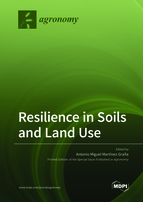Resilience in Soils and Land Use
A special issue of Agronomy (ISSN 2073-4395). This special issue belongs to the section "Soil and Plant Nutrition".
Deadline for manuscript submissions: closed (1 September 2022) | Viewed by 24712
Special Issue Editor
Interests: applied geomorphology; remote sensing and GIS; environmental geology; geomorphology and geological risk
Special Issues, Collections and Topics in MDPI journals
Special Issue Information
Dear Colleagues,
The characteristics of a soil (texture, structure, etc.) and its qualities (vulnerability, fertility, etc.) condition, from the environmental point of view, the geophysical, biotic, landscape and socioeconomic environment of each territory. Currently, studies on land use in territorial planning are of interest, the purpose of which was previously to analyze the aptitude of each type of land for a specific use, based on its ability to assume impacts and the potential that the land may have had. The analysis of erosive risks constitutes a parameter to take into account in said management.
The scientific community, given the enormous social interest in monitoring and controlling the environment, is developing methodologies that allow such control that is more efficient. One of the environmental factors to consider is the soil, which constitutes the support for life and is one of the basic natural elements, which is evident in the European Soil Charter, of the Council of Europe, which says, in its First point: “The soil is one of the most precious goods of Humanity. It allows the life of plants, animals and man on the surface of the Earth”. This European charter also highlights the scarcity and fragility of the edaphic resource, indicating that it must be protected through a greater effort in scientific research and interdisciplinary collaboration to ensure the rational use and conservation of soil.
Due to the consideration of soil as a nonrenewable resource due to its regeneration time scale, the need to delve into the study of the importance of soils in the uses of the territory and the effects of soil degradation and erosive risks is established, due to concerns raised worldwide by desertification problems, stating that desertification precedes desertification. Considering the millions of hectares of arable land area, taking into account that a large part must be subtracted due to fallow situations, we would have 0.39 Ha/inhabitant if we consider a population of 40 million, which indicates that there is already a soil deficit, so the erosive processes, desertification and population growth make the situation worse.
Prof. Dr. Antonio Martinez Graña
Guest Editor
Manuscript Submission Information
Manuscripts should be submitted online at www.mdpi.com by registering and logging in to this website. Once you are registered, click here to go to the submission form. Manuscripts can be submitted until the deadline. All submissions that pass pre-check are peer-reviewed. Accepted papers will be published continuously in the journal (as soon as accepted) and will be listed together on the special issue website. Research articles, review articles as well as short communications are invited. For planned papers, a title and short abstract (about 100 words) can be sent to the Editorial Office for announcement on this website.
Submitted manuscripts should not have been published previously, nor be under consideration for publication elsewhere (except conference proceedings papers). All manuscripts are thoroughly refereed through a single-blind peer-review process. A guide for authors and other relevant information for submission of manuscripts is available on the Instructions for Authors page. Agronomy is an international peer-reviewed open access monthly journal published by MDPI.
Please visit the Instructions for Authors page before submitting a manuscript. The Article Processing Charge (APC) for publication in this open access journal is 2600 CHF (Swiss Francs). Submitted papers should be well formatted and use good English. Authors may use MDPI's English editing service prior to publication or during author revisions.
Keywords
- soil quality
- soil and biodiversity
- soil and geodiversity
- soil–water ratio
- erosion risks
- land use planning
- edaphic resilience and crops
- agronomy and habitats
- agronomy and vegetation
- environmental economics and edaphic productivity
- environmental impact in edaphology
- edaphological heritage
- soil modeling and mapping






